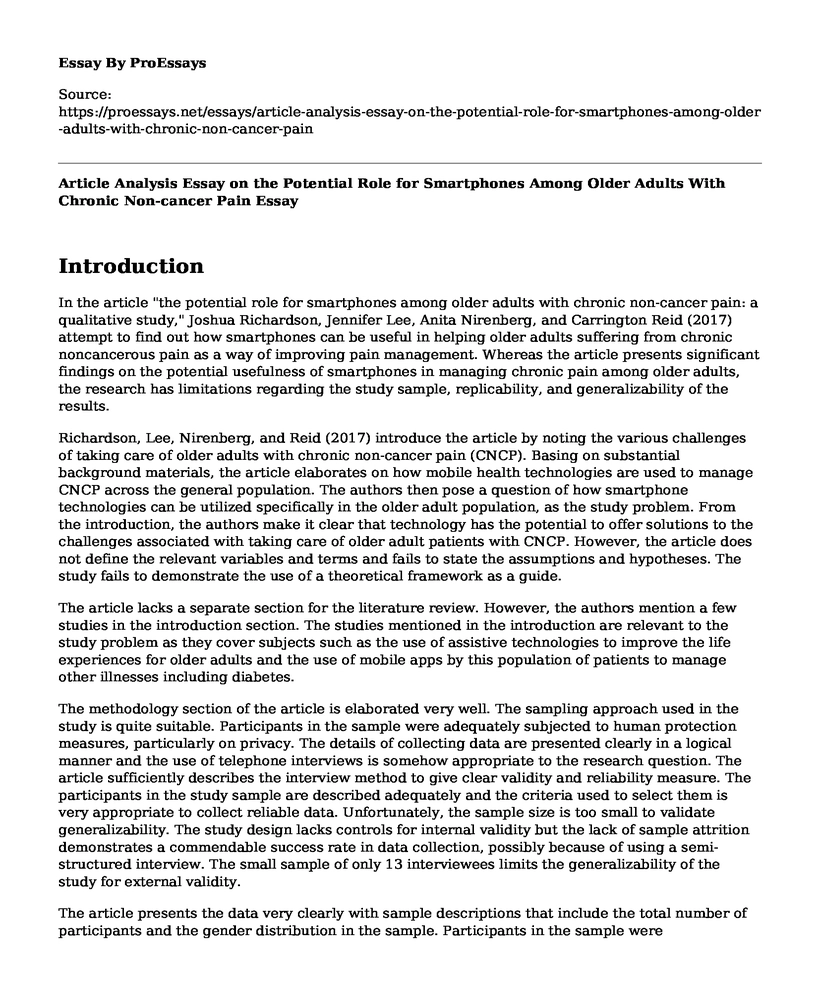Introduction
In the article "the potential role for smartphones among older adults with chronic non-cancer pain: a qualitative study," Joshua Richardson, Jennifer Lee, Anita Nirenberg, and Carrington Reid (2017) attempt to find out how smartphones can be useful in helping older adults suffering from chronic noncancerous pain as a way of improving pain management. Whereas the article presents significant findings on the potential usefulness of smartphones in managing chronic pain among older adults, the research has limitations regarding the study sample, replicability, and generalizability of the results.
Richardson, Lee, Nirenberg, and Reid (2017) introduce the article by noting the various challenges of taking care of older adults with chronic non-cancer pain (CNCP). Basing on substantial background materials, the article elaborates on how mobile health technologies are used to manage CNCP across the general population. The authors then pose a question of how smartphone technologies can be utilized specifically in the older adult population, as the study problem. From the introduction, the authors make it clear that technology has the potential to offer solutions to the challenges associated with taking care of older adult patients with CNCP. However, the article does not define the relevant variables and terms and fails to state the assumptions and hypotheses. The study fails to demonstrate the use of a theoretical framework as a guide.
The article lacks a separate section for the literature review. However, the authors mention a few studies in the introduction section. The studies mentioned in the introduction are relevant to the study problem as they cover subjects such as the use of assistive technologies to improve the life experiences for older adults and the use of mobile apps by this population of patients to manage other illnesses including diabetes.
The methodology section of the article is elaborated very well. The sampling approach used in the study is quite suitable. Participants in the sample were adequately subjected to human protection measures, particularly on privacy. The details of collecting data are presented clearly in a logical manner and the use of telephone interviews is somehow appropriate to the research question. The article sufficiently describes the interview method to give clear validity and reliability measure. The participants in the study sample are described adequately and the criteria used to select them is very appropriate to collect reliable data. Unfortunately, the sample size is too small to validate generalizability. The study design lacks controls for internal validity but the lack of sample attrition demonstrates a commendable success rate in data collection, possibly because of using a semi-structured interview. The small sample of only 13 interviewees limits the generalizability of the study for external validity.
The article presents the data very clearly with sample descriptions that include the total number of participants and the gender distribution in the sample. Participants in the sample were differentiated based on their sex, the type of their pain, age range as well as ownership and regular use of mobile devices. A qualitative method of data analysis is used but there is no single table, graph or chart for the results. The results highlight three potential use of smartphones in managing CNCP among older adults. They include medication management, enabling communication with healthcare service providers, and enhancing social support for the patients.
In the discussion section, Richardson, Lee, Nirenberg, and Reid (2017) present findings that are not only based on the results but also go beyond the research question. The evidence presented is adequate to conclude that smartphones can be helpful in managing CNCP among the older population and researchers make the study limitations clear to readers. The interpretation of the results fits concisely the research problem and the researchers make comprehensive generalizations and conclusions on how useful smartphone technologies can be to older adult patients. The generalizations fairly align with the research findings, which make impactful contributions in the knowledge of nursing on CNCP management.
In a brief but precise conclusion, the article notes the importance of mHealth designs that cater to the needs of patients, who are reportedly willing to use smartphone technologies to improve their life. Lastly, the article recommends further studies to focus on how technological inventions can meet patient needs.
Reference
Richardson, J., Lee, J., Nirenberg, A., & Reid, M. (2017). The Potential Role for Smartphones Among Older Adults with Chronic Noncancer Pain: A Qualitative Study. Pain Medicine, 19(6), 1132-39. doi: 10.1093/pm/pnw284
Cite this page
Article Analysis Essay on the Potential Role for Smartphones Among Older Adults With Chronic Non-cancer Pain. (2023, Mar 14). Retrieved from https://proessays.net/essays/article-analysis-essay-on-the-potential-role-for-smartphones-among-older-adults-with-chronic-non-cancer-pain
If you are the original author of this essay and no longer wish to have it published on the ProEssays website, please click below to request its removal:
- Case Study E-Waste Paper Example
- How AI Can Threat Our Security? - Essay Sample
- The Use of Renewable Sources of Energy in the Construction of Green Buildings Paper Example
- AI and Society: Ethical Guidelines for Coexistence - Essay Sample
- Apple: Innovative Technology and Revolutionary Design - Essay Sample
- How Does Mobile Phone Use Impact Reaction Times? - Essay Sample
- The iPhone Marketing - Report Sample







